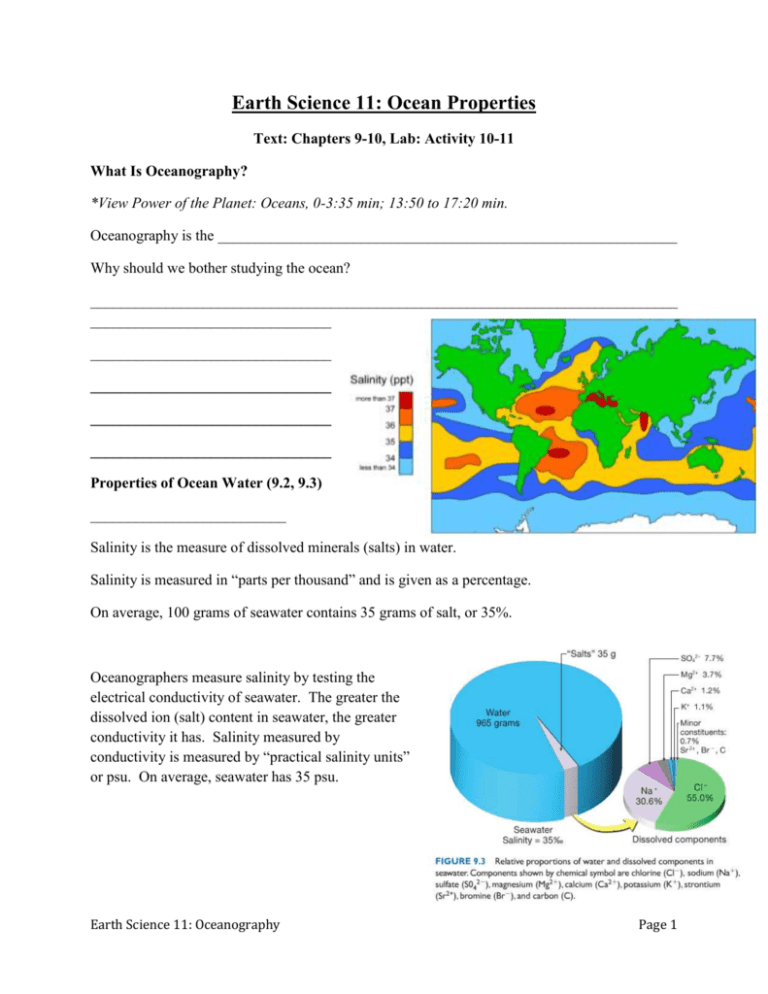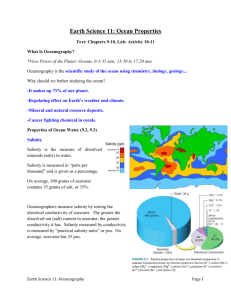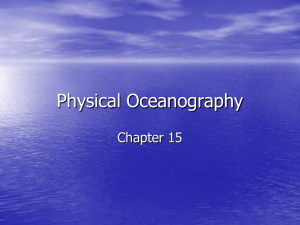File
advertisement

Earth Science 11: Ocean Properties Text: Chapters 9-10, Lab: Activity 10-11 What Is Oceanography? *View Power of the Planet: Oceans, 0-3:35 min; 13:50 to 17:20 min. Oceanography is the _____________________________________________________________ Why should we bother studying the ocean? ______________________________________________________________________________ ________________________________ ________________________________ ________________________________ ________________________________ ________________________________ Properties of Ocean Water (9.2, 9.3) __________________________ Salinity is the measure of dissolved minerals (salts) in water. Salinity is measured in “parts per thousand” and is given as a percentage. On average, 100 grams of seawater contains 35 grams of salt, or 35%. Oceanographers measure salinity by testing the electrical conductivity of seawater. The greater the dissolved ion (salt) content in seawater, the greater conductivity it has. Salinity measured by conductivity is measured by “practical salinity units” or psu. On average, seawater has 35 psu. Earth Science 11: Oceanography Page 1 Where do ocean salts come from? ______________________________________________________________________________ ______________________________________________________________________________ ______________________________________________________________________________ ______________________________________________________________________________ The salinity of sea water is modified through changes to the water content of the solution. *Watch the video on Ocean Salinity. Interpret the Temperature and Salinity Chart, record the salinity level for the following locations and provide a reason to explain it: a) Equator ___________________________________ ______________________________________________________________________________ b) Tropics of Cancer and Capricorn ______________________________________________________________________________ ______________________________________________________________________________ c) Vancouver’s Latitude ______________________________________________________________________________ d) Arctic Circle ______________________________________________________________________________ ______________________________________________________________________________ e) Antarctic Circle ______________________________________________________________________________ ______________________________________________________________________________ Earth Science 11: Oceanography Page 2 *Variations in surface salinity levels are the product of differences in evaporation and rainfall rates. For example, the Dead Sea has a high evaporation and low precipitation rate, giving it 330% salinity. Its high density means that it has a high buoyancy, allowing swimmers to float easily. __________________________________ The ocean is divided into three temperature layers, which vary in their characteristics depending on latitude and depth: *Watch the video on Ocean temperature and density. a) Surface, Low Latitude -Warmed by the sun, with wind/waves mixing heat evenly. -2% of the Ocean’s volume, but biologically important. Many autotrophs here generate an abundance of oxygen. -Its depth and temperature varies with latitude and season. b) Middle Zone, Low Latitude -Thermocline is here, where temperatures and oxygen levels change dramatically. -Verticle barrier to marine life. c) Deep Water and Poles -Little sunlight reaches, making it cold and dense. This allows it to sink from the poles along the ocean’s floor under other layers. -Minor warming in the summer means a weak thermocline for some polar regions. Earth Science 11: Oceanography Page 3 ______________________________ a) Surface, Low Latitude -Low density due to high surface water temperature. b) Middle, Low Latitude -Density levels decrease rapidly as water gets colder (Pycnocline). c) Deep Water and Poles -Very high density as water is very cold. *Complete Activity 10.4 and 10.5 pg. 175 - 179 Ocean Layering Layering occurs due to density, which is a product of water temperatures. a) Surface Mixed Zone has lower density due to warm temperatures generated by sunlight and heat mixing (wind and waves). b) Transition Zone contains the thermocline and pycnocline. c) Deep Zone is very dense due to consistently cold temperatures. Earth Science 11: Oceanography Page 4 Ocean Bathymetry (9.4) Bathymetry is the measurement of ocean depths and the charting of the ocean floor’s topography. *Watch the Ocean Measurement Video for a brief survey of modern bathymetry methods. Through bathymetry oceanographers have identified three main areas of the ocean’s floor: *Complete Activity 10.2 Continental Margins Continental margins are the outer edges of continents where the oceanic crust transitions into the oceanic crust. Earth Science 11: Oceanography Page 5 *Watch the video on Continental Margins and complete the notes below. There are two types of continental margins: a) _____________ _______________ _______________ Geologically inactive and therefore not prone to earthquakes or volcanoes. i) Continental Shelves are gently sloping continental crust covered with eroded sediments from the continent. Their only features are glacial erosion and ancient shelf valleys that used to be river valleys before sea levels rose after the last ice age. ii) Continental Slopes are the steep boundaries between continental and oceanic crust. iii) Continental Rise is a gradually incline of sediments that have swept down the continental slope through turbidity currents (see below) to form deep-sea fans. iv) Submarine Canyons have been created by turbidity currents, the downslope movement of dense, sediment saturated water. Earth Science 11: Oceanography Page 6 b) ________________________ _________________________ Are located along geologically active areas, typically subduction zones (Ring of Fire). Features include: Accretionary wedges of sediment and oceanic crust scraped off by the subduction process accumulating on the overlying plate. Subduction erosion of the overlying plate. Deep-Ocean Basins Deep-ocean basins exist between the continental shelf and oceanic ridges and contain many spectacular features: Earth Science 11: Oceanography Page 7 a) Deep-Ocean Trenches -Deepest part of the ocean and mostly found around subducation zones (Ring of Fire) -Formed by subduction of oceanic lithosphere and as such are associated with earthquakes and volcanic activity (volcanic island arcs and continental volcanic arcs). b) Abyssal Plains -Deep and flat sections of the ocean floor formed by the accumulation of sediments from turbidity currents, precipitation from saltwater solution and dead marine organism shells/skeletons over the ocean crust. c) Seamounts and Volcanic Islands -Submarine volcanoes that can become volcanic islands. -Formed by hot spots activity (Hawaii) or oceanic ridges (Azores) d) Guyots are inactive volcanic islands weathered and eroded below sea level. e) Oceanic Plateaus are flat structures created by the solidification of fluid basaltic lavas. *Apply the names in this section to the diagram below. Earth Science 11: Oceanography Page 8 Oceanic (Mid-Ocean) Ridges Found at divergent plate boundaries, oceanic ridges are formed by the solidification of magma and represents the formation of new oceanic crust. Earth Science 11: Oceanography Page 9 Earth Science 11: Ocean Currents, Tides and Shoreline Erosion Surface Currents (10.1) *Watch the Surface Ocean Smartfigure and answer the questions below. Ocean surface currents are set in motion by the wind and as such closely correspond to surface wind patterns. Most ocean surface currents in the world follow a circular movement called a Gyre. Why do you think ocean currents move in a circular movement? _______________________________________________ _______________________________________________ Do surface ocean currents affect coastal climates? _______________________________________________ Upwelling and Deep-Ocean Circulation (10.1) Upwelling *Watch the Upwelling Smartfigure and answer the questions below. Other than creating surface currents winds can also generate vertical water displacement, such as coastal upwelling. Why is upwelling important to life in the photic zone? ____________________________________________________________ ____________________________________________________________ ____________________________________________________________ ___________________________________________________________ Earth Science 11: Oceanography Page 10 Deep Ocean Circulation Other than upwelling, ocean water can be displaced vertically be deep-ocean circulation. What is the primary cause of deep-ocean circulation? -Water densities (in response to temperature and salinity). Amazingly, water that sinks at Antarctica may not re-emerge at the surface for 500 to 2000 years! The Shoreline (10.3) Ocean Waves (10.4) *Watch the Ocean Waves Smartfigure and complete Activity 11.1 and 11.2 Beaches and Shoreline Processes (10.5) a) Wave Weathering and Erosion Waves can cause the breakdown of beach materials (weathering) in several ways: i) Pressure: -Every wave can put thousands of kilograms per square metre on a surface. -Water forced into rock cracks compresses the air found there, which then expands when the wave recedes and dislodges rock fragments and enlarging fractures. ii) Abrasion: -Waves carrying sediments or larger rocks can wear down shorelines and beach materials. Earth Science 11: Oceanography Page 11 Sand Movements on a Beach Energy from waves crashing into a beach can cause sand to move in two ways: a) Perpendicular to the Shore: Beaches gain sand in low-energy wave conditions as the swash (water produced from collapsing breakers) can absorb the energy and reduce the amount of backwash. Beaches lose sand in high-energy wave conditions as the swash cannot absorb all of the energy and as such the backwash is much stronger. b) Wave Refraction: *Watch the Wave Refraction Smarfigure In the image above, where would the most erosion occur? Why? -On the headland, as waves feel bottom here first and are bent parallel to attack all sides of the headland. Concentrates wave energy on a relatively narrow section of the coast. In the image above, where would sediments be deposited? Why? -On the beaches, as refraction causes the waves to spread out and expend less energy. Low energy allows sediment deposition. Earth Science 11: Oceanography Page 12 c) Parallel to the Shore *Watch the Longshore Current Smartfigure and complete Activity 11.4 Although waves are refracted most still reach the shore on a small angle, causing sediments to be carried parallel to the shoreline. Backwash sets up the perpendicular movement of sand. Together, these processes are called Beach Drift. Longshore currents are also created by waves approaching the shore at a consistent angle that can also move sediments in the same direction as the beach drift. Shoreline Features (10.6) *Complete Activity 11.5 Shoreline Stabilization (10.7) Conduct your own research into one method of Shoreline stabilization. You will present a small presentation on this method to the class. Your presentation must include: a) What the stabilization method is and whether it is considered “hard” or “soft” (see your text for clarification. b) The stabilization method’s effectiveness and its weaknesses, including environmental impact. c) An image of the stabilization technique. Tides (10.9) *Explore this section of the text and lab out of personal interest, it will not be tested! Earth Science 11: Oceanography Page 13








